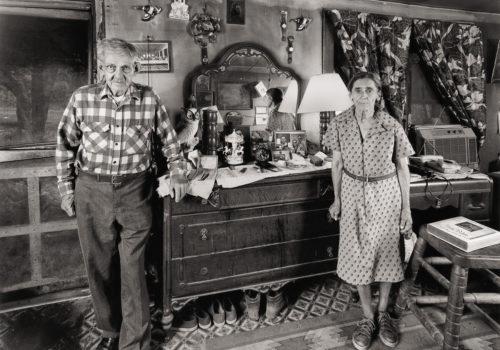Some vilifications resist easy erasure. Hillbillies, throughout the twentieth century, suffered a poor image as moonshining, clan-feuding rednecks whose lack of education and manners made them prone to lawlessness. It found vigorous and enduring expression in Deliverance, a 1972 movie that cast Appalachian backwoodsmen as feral and insular and, while that film was set in Georgia, such stereotyping crossed Appalachia and included mountain communities in eastern Kentucky.
Shelby Lee Adams began photographing the people of eastern Kentucky, his childhood home, in 1974. He started with family, friends and neighbours, gaining their trust and, through introductions to people they knew, embarked on regular summer visits to deepen his knowledge of the area. This turned into four decades of visiting and recording a way of life that, he came to increasingly realize, deserved recognition and respect. Born into a financially secure family himself, Adams got to know those less fortunate than himself and, as he puts it in the appealing documentary film The True Meaning of Pictures, he sought to ‘make right what the media has done wrong’. The documentary, noting how in the 1960s journalists came to eastern Kentucky to focus on the region’s decline and impoverishment, shows how Adams was accepted into a culture that was fairly unique in some regards – witness the religious snake-handling shown in the film – and with positive qualities that he captured with his camera.
His work first reached a wide audience with the publication of his Appalachian Portraits (1993). Now in his early seventies, Adams is editing and organizing previously unpublished black and white photos and From the Heads of the Hollers is impressive testimony to this archive. A holler, from the local pronunciation of ‘hollow’, refers to the valley spaces cut by creeks between hills and mountains where people in isolated parts of eastern Kentucky built their homes and communities. While geographic or historical specificity is not the explicit subject matter of a collection dedicated to portraits, an abiding sense of a place, a time and a way of life emerges from the photographs.
The hard life of the people in From the Heads of the Hollers is etched on their faces and stances. An elderly husband and wife, Clay and Cora, stand either side of a chest of drawers – he rests one hand on it while she still stands more erect, arms by her side – its top is filled with framed photographs, a clock, hairbrush and combs, spectacles and other items; footwear is tucked underneath. A large Bible rests on a stool and a reproduction of da Vinci’s The Last Supper hangs on the wall with an incongruous set of decorations. The couple address the camera with frankness – they are not abashed by their humble dwelling – bearing out Adams’ claim that he finds the people of the eastern Kentucky mountains ‘direct and transparent’. The photograph, spread across two pages of a large book anyway (25.4 by 30.48 cm), is both art and a document: a commemoration of a shared life and a salute to their existence away from the madding world.
Another couple, Lonnie and Leddie, stand for their portrait against the exterior planks of a house. The materiality of their lives is indicated, not by meagre possessions around a chest of drawers but by way of an electricity meter above their heads. The difference in their way of standing is not unlike that of Clay and Cora, one of them adopting a more informal pose than the other, and like them their furrowed faces bear witness to the rugged reality of their environment.
There is no despair but smiling faces are not a characteristic of the portraits, whether a couple or single, adult or child, and Adams’ selection for this book indicates a spectrum of outlooks and mindsets. Some, he says, ‘are withdrawn and some have suffered from years of poverty or isolation or societal neglect’ and this aspect comes across most strongly when his subjects are single individuals.. He goes on to say: ‘Looking at and sharing pictures with each other, as I do with the people I photograph, confirms who we are.’
Confirmation goes to the heart of Adams’ photography and makes his work singular, memorable and, in the way he smashes received images of hillbillies, iconoclastic.
Sean Sheehan
Shelby Lee Adams : From The Heads of The Hollers
Gost Books
280 x 360 mm
176pp, 89 images
Hardback, clothbound cover
https://gostbooks.com/en-us/products/from-the-heads-of-the-hollers
Une exposition From the Heads of the Hollers est présentée à la Paul Paletti Gallery à Louisville, Kentucky jusqu’au 29 décembre 2023.
Paul Paletti Gallery
713 E Market St.
Louisville, KY 40202
www.paulpalettigallery.com
















